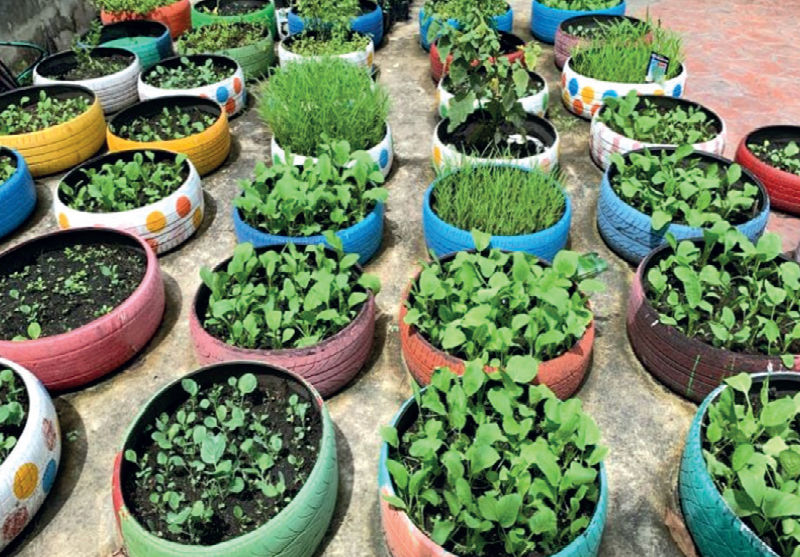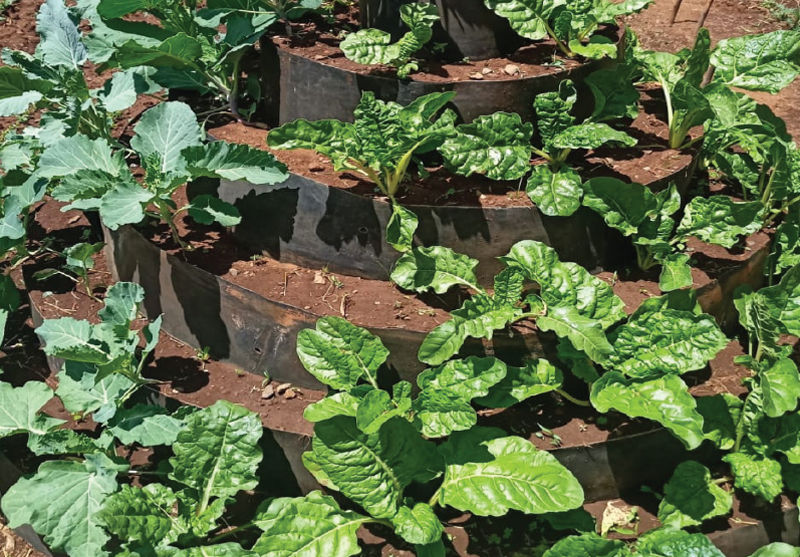Kitchen Garden
Food security is one of the important aspects of a healthy society. To promote food security, households should embrace kitchen gardens. A Kitchen garden ensures a regular and ready supply of fresh vegetables, fruits and herbs.
Activity 1
Explaining the meaning of food and nutrition security
Work in groups
- Using print resources, digital devices and journals search for the meaning of food and nutrition security.
- Discuss your findings and share with other learners.
Learning points
- Food and nutrition security exists when all people at all times have access to sufficient, safe and nutritious food that meets their dietary needs and food preferences for healthy living.
- Kitchen garden is any convenient size of a plot, space or structure located in a home where a variety of crops are grown mainly for family consumption.
Role of a kitchen garden in food and nutrition security
Food security focuses on the constant production and supply of nutritious food. A kitchen garden plays a major role in ensuring a steady supply of nutritious food at all times.
Activity 2
Explaining the role of a kitchen garden in food and nutrition security
Work in groups
Study the picture shown.
- Name the crops shown in the picture.
- What are the benefits of having a kitchen garden at home?
- How does kitchen gardening contribute to food and nutrition security?
Explore More
- Search the Internet for more information on the roles of a kitchen garden in food and nutrition security.
- Share your findings with other learners.

Learning points
The role of a kitchen garden in food and nutrition security include:
- Production of safe, fresh food that is accessible to the family.
- Reliable source of green leafy vegetables, herbs, fruits, legumes and cereals for home consumption.
- Growing of both seasonal and off-season crops which ensures steady supply of nutritious foods.
- Help the family to meet their nutritional needs and promote healthier lifestyles.
- Generates income from the sale of surplus produce.
- Helps save family income.
- Provides alternatives when staple foods are not in stock.
- Helps to increase food production.
- Some forms of kitchen gardening use recycled materials like plastics hence contributing to environmental conservation.
Innovative technologies for kitchen garden
The increase in population and urbanisation has led to limited space to establish large gardens. Innovative technologies ensure proper use of the small available space for maximum production of food.
Activity 3
Describing innovative technologies for kitchen gardening
Below are pictures showing various forms of kitchen gardens. Observe the pictures keenly.
Forms of kitchen gardens
Work in groups
- Describe the various forms of kitchen gardens shown.
- Discuss other innovative ways of establishing a kitchen garden in your locality.
- Share your findings with other learners.
Explore More
- Search the Internet for more information on the various forms of kitchen gardens.
- Discuss the meaning of tyre, wick, simple drip, container and multistorey gardens.
- Record your findings and share with other learners.
Learning points
- Innovative gardening aims at maximising the small available space with proper water conservation measures in crop production. Examples of innovative kitchen gardens include; container, wick, hanging pots, tyre, multi-storey garden, simple drip and organic sack garden.
- Most of the innovative kitchen gardens focus on vertical garden, which keep plants off the ground as opposed to horizontal gardening.
- Multi-storey garden involves filling a bag, sack or container with soil and manure then planting vegetables on the top or sides. Multi-storey garden requires little space.
- Container garden is developed by planting crops in a container such as earthen pots, wooden boxes and plastic containers. The garden is not appropriate for deep rooted crops.
- Simple drip garden is an innovative technology which involves the use of plastic bottles and jerricans. It involves the use of two containers. The first container is filled with soil and manure where crops are planted. The second container is placed directly above the first container and filled with water. It has a tiny hole at the bottom that allows water to drip.
- Wick garden is a modern technology of using underground irrigation system. The crop is planted in a container which is placed on another container filled with water. A wick connecting the bottom container with the top container draws water up feeding the crop at the top.
- The technology is ideal especially for areas with little space. It also helps in water conservation.
Benefits of innovative gardens
Innovative kitchen gardens have several advantages which include:
- Use of locally available materials.
- Requires little amount of water.
- Easy to manage because less labour is required.
- Makes good use of little space.
- Some are portable.
- High productivity.
- Aesthetic value around the compound.
- Ideal for urban areas and congested homesteads.
Food crops suitable for growing in a kitchen garden
Kitchen garden is ideal for growing food for home consumption. The crops grown are the ones that require smaller space. Both seasonal and perennial crops especially fruits can be grown in a kitchen garden.
Activity 4
Classifying food crops suitable for growing in a kitchen garden
Below are crops that can be grown in a kitchen garden. Observe the pictures keenly.

Crops that can be grown in a kitchen garden.
Work in groups
- Name the crops shown in the pictures.
- Discuss other crops that can be grown in a kitchen garden.
Search the Internet and print resources for other crops which can be grown in a kitchen garden. - Classify the crops as per their respective groups. Share your findings with other learners in class.
Vegetables | |||
Herbs | |||
Cereals | |||
Fruits | |||
Legumes |
Learning points
Food crops suitable for growing in a kitchen garden can be classified as follows:
- Vegetables: for example kales, spinach and cabbage.
- Herbs and spices: for example dhania, rosemary leaves and garlic.
- Cereals: for example maize.
- Fruits: for example passion fruits, paw paws and ripe bananas.
- Legumes: for example beans, cow peas and garden peas.
How to establish a kitchen garden
In agriculture, you have already learnt about gardening practices like watering, pest control, application of manure, weeding, mulching and thinning. These are important techniques of growing, management and care of crops in the provision of healthy and affordable food.
Project
A kitchen garden
Work in groups
- Your teacher will guide you set up a kitchen garden in school.
Considerations when setting up a kitchen garden
What to check before setting up a kitchen garden | Yes/No |
|
|
|
|
|
|
|
|
|
|
- Based on the information gathered, discuss and select the suitable site for setting up the kitchen garden.
- Discuss the following questions for planning purpose. Present your findings in class.
- What is the available space and sunshine direction?
- Is adequate clean water available?
- Which appropriate innovative gardens can be set up?
- What inputs will be required? (seeds, seedlings, tools and equipment)
- How will you acquire the necessary inputs, tools and equipment?
- The key focus in the project will be:
- Selection of appropriate, innovative kitchen garden.
- Planning on the crops to be grown.
- Different groups can choose various food crops to grow in their kitchen gardens.
- Use organic gardening. Remember to include indigenous vegetables.
- Developing a card or book for keeping farm records.
- Deciding on the preparation, gardening practices and management of the produce.
Note:
- Ensure you observe safety precautions while using the farm tools.
- It is important to take photos of each step especially during preparation, planting and crop management process of the kitchen garden.
Activity 5
Creating and modelling kitchen gardens at school using modern techniques
Your teacher will guide you to create and model kitchen gardens at school using modern techniques. A minimum of five groups will be required. Each group should prepare a different form of kitchen garden using modern techniques. An example of how to make a modern kitchen garden has been provided.
Making container kitchen garden
Preparing, planting and maintaining various food crops.
You will require
Containers, jembe, panga, watering can, spade, planting materials like seeds, suckers or seedlings, manure, gardening soil, clean source of water and mulching materials.
Steps
- Collect the required materials, tools and equipment.
- Mix the soil and manure in the correct proportion.
- Put the mixture in the container.
- Sow the seeds or plant the seedlings.
- Regularly water the plants.
- Carry out gardening practices required. This will be a continuous exercise.
Remember to record all the farm activities carried out and note the date for each activity.
Class activity
- Share your experiences on the kitchen garden activity.
- Discuss the challenges you faced in establishment and management of a kitchen garden.
- What are the benefits of a kitchen garden to your community?
Activity 7
Keeping records for the kitchen garden.
Work in groups
- Search the Internet and print materials for samples of weekly garden reports and garden files.
- Copy the samples in your exercise books.
- Create a garden portfolio using the photos taken during preparation, planting and crop management process of the kitchen garden.
- Present the weekly garden reports, garden file and garden portfolio during class plenary.
Learning points
Importance of keeping farm records
- For planning purposes and budgeting.
- Helps to monitor progress of farm activities like weeding, watering and know the changes to be made.
- Helps to make informed decisions and manage the garden well.
- To keep track of farm activities carried out like mulching, pest control, thinning, pruning and watering. This will help to improve farm management so as to understand how various crops perform.
Sample weekly report
The sample provided will guide you to record what is happening in the farm. You may modify or improve it to suit your needs.
Note:
Records should be written down immediately after performing the task.
Self assessment
- Caroline a grade eight learner was asked by the teacher to make a presentation on the role of a kitchen garden during parents meeting.
State four points that she should highlight during her presentation. - There are various forms of innovative kitchen gardens. Name three forms of kitchen gardens appropriate for a family living in a storey building.
- Grade eight leaners were asked to state and give examples of food crops suitable for growing in a kitchen garden. The following are responses from three learners.
Tilda: Legumes - kales, spinach, cabbage, eggplant.
Carl: Herbs - Rosemary, cilantro, basil.
Terry: Root Vegetables - Capsicum, onions, garlic.
Which learner gave the correct response? - Wendy wanted to establish a kitchen garden. She collected the following items: Jerrican, plastic bottle, knife, poles, string, water, garden soil, manure. Which innovative kitchen garden was she planning to make?
- Leseru is planning to set up an innovative kitchen garden. He has decided to apply organic gardening practises. Give two benefits of organic gardening.




